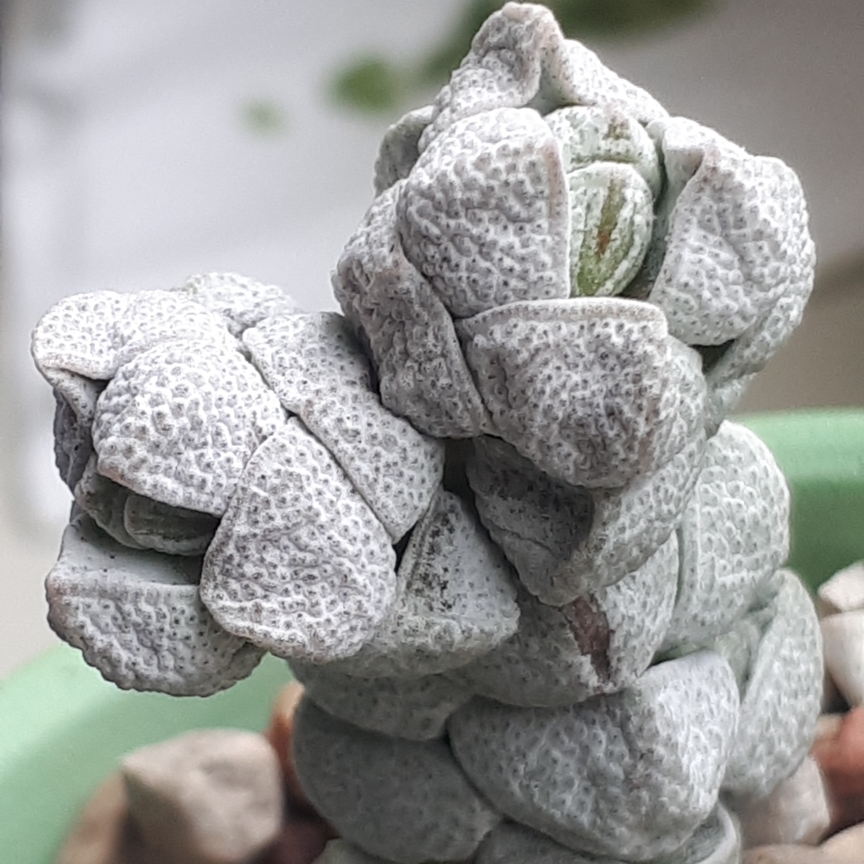
Crassula deceptor syn. Crassula deceptrix
Crassula Deceptor
Crassula deceptor is a variable small succulent that stays relatively low to the ground and clumps readily. It is a dwarf columnar succulent, usually solitary or occasionally branched. It is native to Namibia and the Northern Cape of South Africa. The base stem of the deceptor can reach up to 15 cm tall. Leaves grow up to 2 cm long, in overlapping pairs along a usually unbranched stem, tightly imbricated, rounded at the base of the leaf, pointed in the shape of canoes which stack off a central stem and produce a square pillar. The leaves are grey-green and covered with a light, white powdery surface. These characteristics help crassula deceptor to preserve moisture and protect itself from strong sunlight. Crassula deceptor produces a branched loose cyme of very small, pinkish, sweet-scented flowers. Flowers can appear in any time of the year when conditions are appropriate, but they tend to be produced mainly during the winter, as these are basically southern hemisphere plants.
-
Full sun
-
Very little water
-
Not Frost hardy
-
Light and free draining
Common name
Crassula Deceptor
Latin name
Crassula deceptor syn. Crassula deceptrix
type
Succulent
family
Crassulaceae
ph
5.0 - 7.5 Acid - Neutral
Plant & bloom calendar
-
Best time to plant
full grown dimensions
 0.60 M
0.60 M
0.60 M
0.60 M
Crassula deceptor syn. Crassula deceptrix
Crassula deceptor is a variable small succulent that stays relatively low to the ground and clumps readily. It is a dwarf columnar succulent, usually solitary or occasionally branched. It is native to Namibia and the Northern Cape of South Africa. The base stem of the deceptor can reach up to 15 cm tall. Leaves grow up to 2 cm long, in overlapping pairs along a usually unbranched stem, tightly imbricated, rounded at the base of the leaf, pointed in the shape of canoes which stack off a central stem and produce a square pillar. The leaves are grey-green and covered with a light, white powdery surface. These characteristics help crassula deceptor to preserve moisture and protect itself from strong sunlight. Crassula deceptor produces a branched loose cyme of very small, pinkish, sweet-scented flowers. Flowers can appear in any time of the year when conditions are appropriate, but they tend to be produced mainly during the winter, as these are basically southern hemisphere plants.
Propagation by cuttings
From Early Spring TO Late Summer
Crassulas can be grown from leaf cuttings taken in spring and summer. Pull a leaf from the main stem, leave it to dry for a day, then place it on the surface of the growing compost. The leaf will form roots and eventually, a small rosette will appear at the base. Remove and pot up the new plant when well rooted.
Planting
From Early Spring TO Early Summer
Crassulas need a sharply drained soil, such as 2 parts John Innes potting compost number 2 and 1 part course sand or grit. They do best on a sunny window ledge and in winter, require a minimum temperature of 7C. Repot every second year in early spring.

















